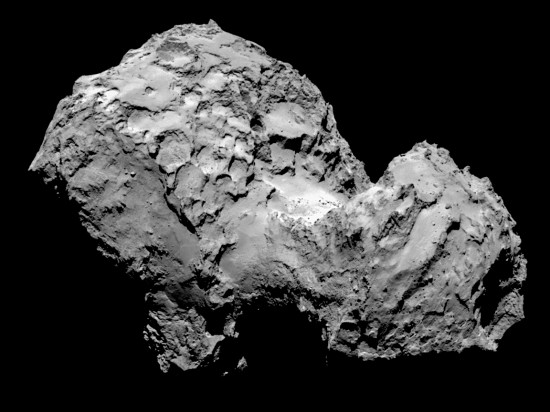
The comet from a distance of 285 kilometers on August 3, 2014. Credit: ESA/Rosetta/MPS for OSIRIS team MPS/UPD/LAM/IAA/SSO/INTA/UPM/DASP/IDA.
Aug 6, 2014
Rosetta is orbiting Comet 67P/Churyumov–Gerasimenko
A little more than half way between Mars and Jupiter, at around 400 million kilometers from Earth, the Rosetta cometary probe completed its maneuvers and settled into orbit around 67P/C-G. Mission team members are analyzing images, in order to determine an appropriate site for the Philae lander, which will attempt to make contact with the surface sometime in the next few months. One particular area looks promising.
One of the comet’s most striking aspects, seen in the image at the top of the page, is that it does not look like a ball of ice and dust. Rather, it looks like a piece of slag from a blast furnace. That idea does not conform to the prevailing opinions about comets. As the Rosetta mission web page states:
“We think that comets formed about the same time as the giant planets of our solar system…That was about 4.6 billion years ago…Some scientists think that comets are made from the same clumps of dust and ice that erupted from our sun’s birth.”
In an Electric Universe, comets are most likely the result of cosmic electric discharges that devastated the solar system within the last few thousand years. As physicist and natural philosopher Wal Thornhill wrote: “In the Electric Universe model it is futile to look for remnants of the primordial gas and dust from which the solar system is supposed to have collapsed. Comets are not primordial composites. The matter in comets (and asteroids and meteoroids) has been through several processes, first in a star, then within a gas giant and possibly a rocky planet before being discharged into space.”
As previously written, when the Giotto probe met Halley’s Comet on March 16, 1986, it was found that the comet was covered with a black crust. Bright jets of plasma blasted out from its surface in three highly localized areas. Uwe Keller of the Max Planck Institut für Aeronomie said at the time: “We discovered that a comet is not really a ‘dirty snowball’ since dirt is dominant, not ice. Instead of being spherical like a warm snowball, a comet nucleus is elongated. The physical structure of a comet’s interior is defined by its dust content rather than its ice content.” This comment corresponds to the appearance of 67P/C-G. Rosetta’s VIRTIS ((Visible and Infrared Thermal Imaging Spectrometer) instrument found that the comet’s surface is, “predominantly dark and dusty rather than clean and icy.”
Rosetta will eventually settle into an orbit that will bring it to within 30 kilometers of 67P/C-G, perhaps closer. From the lowest possible orbit it will deploy the Philae lander on November 11, 2014. Onboard Philae are an X-ray spectrometer, several small panoramic cameras, gas analyzers, a magnetometer and plasma analyzer that will monitor the solar wind’s interaction with the comet, as well as other instruments designed to inspect the comet’s density and composition.
It is expected by Electric Universe proponents that there will be puzzles for the Rosetta team. It seems likely that they will find the comet to be dense and rocky, rather than a slushy, porous rubble pile. Indeed, Philae could have difficulty latching on to 67P/C-G, since its harpoon might not be able to penetrate the hard surface. Also, the ice screws that are supposed to keep it anchored may not find any ice into which they can drill.
The next couple weeks of investigation should vindicate Electric Universe theories about comets.
Stephen Smith












